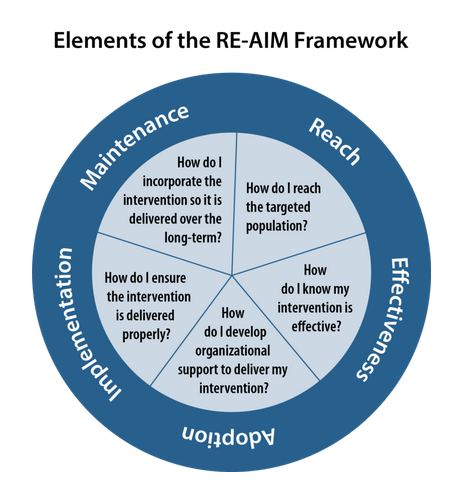RE-AIM 1.0 Framework
D and/or I:
 The focus on dissemination and/or implementation activities. D-only focuses on an active approach of spreading evidence-based interventions to target audience via determined channels using planned strategies. D=I, D>I, and I>D means there is some focus on both dissemination and implementation. I-only focuses on process of putting to use or integrating evidence-based interventions within a setting.
The focus on dissemination and/or implementation activities. D-only focuses on an active approach of spreading evidence-based interventions to target audience via determined channels using planned strategies. D=I, D>I, and I>D means there is some focus on both dissemination and implementation. I-only focuses on process of putting to use or integrating evidence-based interventions within a setting.
D=I Socio-Ecological Levels:
 The level of the framework at which the model operates. Individual includes personal characteristics; Organization includes hospitals, service organizations, and factories; Community includes local government and neighborhoods; System includes hospital systems and government; Policy includes changes in policy.
The level of the framework at which the model operates. Individual includes personal characteristics; Organization includes hospitals, service organizations, and factories; Community includes local government and neighborhoods; System includes hospital systems and government; Policy includes changes in policy.
- Individual
- Organization
- Community
Number of Times Cited:
 The # of times the original publication for the model was cited as indicated by Google Scholar since 2016.
The # of times the original publication for the model was cited as indicated by Google Scholar since 2016.
1360 Field of Origin:
 The field of study in which the model originated.
The field of study in which the model originated.
Public Health Rating:
 These are ratings given by users of the site.
These are ratings given by users of the site.
Constructs:
 Name of the construct developed by classifying/aligning the elements abstracted from models.
Name of the construct developed by classifying/aligning the elements abstracted from models.
Assessment Instruments:
 Name of the assessment developed by classifying/aligning the elements abstracted from models.
Name of the assessment developed by classifying/aligning the elements abstracted from models.
- Acceptability, Practicability, Effectiveness, Affordability, Side-Effects, and Equity (APPEASE)
- Clinical Sustainability Assessment Tool (CSAT)
- Consolidated Framework for Implementation Research (CFIR) Interview Guide (Lam)
- Consolidated Framework for Implementation Research (CFIR) Interview Guide (Zhao)
- Consolidated Framework for Implementation Research (CFIR) Interview Guide Webtool
- Diagnosis Related Group (DRG) Policy Survey
- Dissemination and Implementation Research Capability Self-Survey (DIRC-SS)
- Evidence Based Practice Attitude Scale (EBPAS)
- Goodman's Level of Institutionalization
- Hall's Levels of Use Scale
- Implementation Climate Scale (ICS)
- Implementation Leadership Scale (ILS)
- Implementation Strategy Usability Scale
- Intervention Determinants Item Banks (IDIB)
- Intervention Scalability Assessment Tool (ISAT)
- Inventory of Factors Affecting Successful Implementation and Sustainment (IFASIS)
- Iterative, Practical, Robust Implementation and Sustainability Model (iPRISM) Webtool
- Knowledge Exchange Outcomes Tool
- Local Wellness Policy Implementation Checklist
- Normalization Process Theory Interview Guide
- Normalization Process Theory Questionnaire (NoMAD)
- Partnership/Synergy Assessment Tool
- Policy Coalition Evaluation Tool (PCET)
- Practical, Robust Implementation and Sustainability Model (PRISM) Contextual Survey Instrument (PCSI)
- Practical, Robust Implementation and Sustainability Model (PRISM) Interview Guide
- Pragmatic Context Assessment Tool (pCAT)
- Program Sustainability Index
- Rapid Assessment Procedure Informed Clinical Ethnography (RAPICE) Protocol, Activity, and Interview Prompt Guide
- Rapid Assessment Procedure Informed Clinical Ethnography (RAPICE) Summary Template
- Readiness Thinking Tool - Observation Guide
- Readiness Thinking Tool - Survey
- Readiness for Recovery and Resiliency - Interview Guide
- Rehabilitation Policy Questionnaire
- Research Engagement Survey Tool (REST)
- Research Engagement Survey Tool (REST) - 9 item
- Stages of Implementation Completion (SIC)
- Strategies for Translation and Research Log (STAR Log)
- Sustainability Measure for Healthcare
- Sustainment Leadership Scale (SLS)
- Van Schaik's Technology Acceptance Model (TAM)
Website:
 Website.
Website.
http://www.re-aim.org/
Citations:
 The original publication(s) of the model.
The original publication(s) of the model.
Glasgow RE, Vogt TM, Boles SM. Evaluating the public health impact of health promotion interventions: the RE-AIM framework. Am J Publ Health 1999;89(9):1322–7. Examples:
 Citations of studies that have used the model as an outline for their study.
Citations of studies that have used the model as an outline for their study.
Brant AR, Dhillon P, Hull S, Coleman M, Ye PP, Lotke PS, Folan J, Scott RK. Integrating HIV Pre-Exposure Prophylaxis into Family Planning Care: A RE-AIM Framework Evaluation. AIDS Patient Care STDS. 2020 Jun;34(6):259-266. doi: 10.1089/apc.2020.0004. PMID: 32484743; PMCID: PMC7262643. Read this resource View Case StudyAittasalo M, Miilunpalo S, Ståhl T, Kukkonen-Harjula K. From innovation to practice: initiation, implementation and evaluation of a physician-based physical activity promotion programme in Finland. Health Promot Int 2007;22(1):19.
De Meij JSB, Chinapaw MJM, Kremers SPJ, Jurg ME, Van Mechelen W. Promoting physical activity in children: the stepwise development of the primary school-based JUMP-in intervention applying the RE-AIM evaluation framework. Brit J Sports Med 2010;44(12):879-87.
Glasgow RE, Nelson CC, Strycker LA, King DK. Using RE-AIM metrics to evaluate diabetes self-management support interventions. Am J Prev Med 2006;30(1):67-73.
Van Acker R, De Bourdeaudhuij I, De Cocker K, Klesges L, Cardon G. The impact of disseminating the whole-community project ‚Äò10,000 Steps’: a RE-AIM analysis. BMC Publ Health 2011;11(1):3.
HIV Examples:
Brant AR, Dhillon P, Hull S, Coleman M, Ye PP, Lotke PS, Folan J, Scott RK. Integrating HIV Pre-Exposure Prophylaxis into Family Planning Care: A RE-AIM Framework Evaluation. AIDS Patient Care STDS. 2020 Jun;34(6):259-266. doi: 10.1089/apc.2020.0004. PMID: 32484743; PMCID: PMC7262643. Read this resource View Case StudyThere are no reviews yet. Be the first one to write one.
